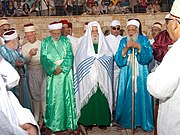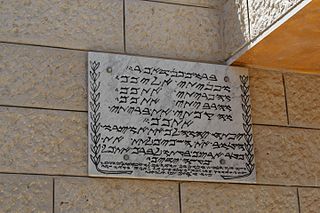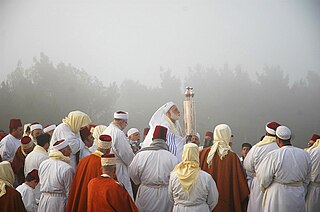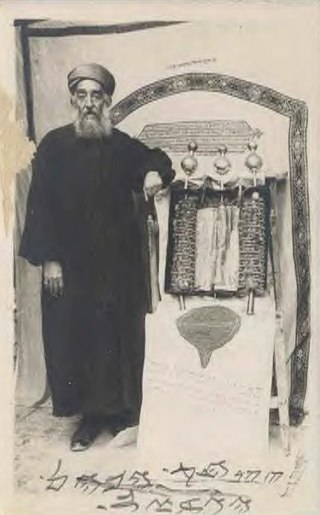| Traditional Numbering | High Priest Name | Term | Comments | Civil name and life data |
|---|
| Aaron I. (אהרן) | | Biblical figure, brother of Moses. He is considered in the Torah to be the "ancestor of the legitimate Levitical-Aaronid priesthood." [6] | |
| Eleazar I. (אלעזר) | | Biblical figure, son of Aaron and his successor as high priest. [7] | |
| Phinehas I. (פינחס) | | Biblical figure, son of Eleazar. Because of his religious "zeal" he and his descendants are awarded a perpetual priesthood. [8] | |
| Abishua I. (אבישע) | | According to Samaritan tradition, Aaron's great-grandson [9] is said to have written down a Pentateuch scroll that is first mentioned by Abū l'Fatḥ in the 14th century and, in a very poor state of preservation, is kept by the Samaritan community as a precious possession. The Abisha Scroll is considered the original of all Samaritan Torah scrolls. [10] | |
| 1 | Sashai ben Abishua | | | |
| 2 | Bakhi ben Sashai | | probably identical to the Jewish High Priest Bukki | |
| 3 | Uzzi ben Sashai | | According to Samaritan tradition, Uzzi hid the tent sanctuary of the desert migration (Mishkan) in a cave at Garizim when the Israelites introduced the cult at Shiloh, which was illegitimate from the Samaritan point of view. [11] | |
| 4 | Shashai II ben Uzzi | | | |
| 5 | Bakhi II ben Sashai | | | |
| 6 | Shembet ben Bakhi | | who served at the shrine to God at Shechem alone | |
| 7 | Shalom I ben Shembet | | | |
| 8 | Hezekiah I ben Shalom | | | |
| 9 | Jonathan I ben Abiathar (ben Hezekiah?) | | According to Samaritan tradition, he is said to have been a contemporary of King David. [12] (2 Samuel 15:27), served as a messenger during Absalom's rebellion (2 Samuel 15:36, 17:17) | |
| 10 | Jair I ben Jonathan | | | |
| 11 | Daliah I | | | |
| 12 | Jair II ben Daliah | | In his time the Jerusalem temple is said to have been built. [12] | |
| 13 | Jonathan II ben Jair | | | |
| 14 | Ishmael ben Jonathan | | | |
| 15 | Tabia I | | This high priest is said to have been murdered by the Ishmaelites. [13] | |
| 16 | Zedekiah I | | | |
| 17 | Ahid | | | |
| 18 | Jair III | | | |
| 19 | Jehozadak | | | |
| 20 | Zadok (צדוק) | | | |
| 21 | Amram I. (עמרם) | | | |
| 22 | Hilkiah or Hezekiah II | | | |
| 23 | Amram II. (עמרם) | | | |
| 24 | Akkub | | | |
| 25 | Akkubiah I | | According to the Samaritan chronicler Abū l'Fatḥ (14th century), Aqabiah was a contemporary of Nebuchadnezzar II and thus of the conquest of Jerusalem by the Babylonians (587 B.C.). [14] He is said to have been led into Babylonian exile with the Israelites. [13] | |
| 26 | Hillel I | | | |
| 27 | Seriah | | He is said to have returned with his people from exile. [13] | |
| 28 | Levi I. (לוי) | | | |
| 29 | Netaniel I | | | |
| 30 | Azariah | | In the 10th year of his high priesthood he is said to have been captured by the Chaldeans. [13] | |
| 31 | Aabed-El I | | This high priest returned from exile; in his time the Samaritan community is said to have had 300,000 members. [13] | |
| 32 | Hezekiah III | | | |
| 33 | Hananiah | | | |
| 34 | Amram III. (עמרם) | | His son is said to have married the daughter of King "Derus"; according to tradition, the Samaritans made a riot and killed both of them. [13] | |
| 35 | Hillel II/Hanan | | This high priest is said to have married the daughter of the king of Assyria and to have been killed by the Samaritans. [15] | |
| 36 | Hezekiah IV | | According to the Samaritan historian Abū l'Fatḥ, Hezekiah was high priest when Alexander III of Macedonia defeated the Persian king Darius. [16] | |
| 37 | Daliah II | | | |
| 38 | Akkub II | | | |
| 39 | Akkubiah II | | | |
| 40 | Levi II. (לוי) | | | |
| 41 | Eleazar II | | | |
| 42 | Manasseh | | the son-in-law of Sanballat the Horonite | |
| 43 | Jair IV | | | |
| 44 | Netaniel II | | | |
| 45 | Joachim | c. 4 BCE | According to Samaritan tradition, Jesus of Nazareth was born during the tenure of Jehoiakim. [17] | |
| 46 | Jonathan III | c. 29 CE | In his time Jesus is said to have been killed "in the cursed Shalem" (= Jerusalem). [15] | |
| 47 | Elishama | | | |
| 48 | Shemaiah | | | |
| 49 | Tabia II | | | |
| 50 | Amram IV. (עמרם) | | | |
| 51 | Akabon I | | | |
| 52 | Phinehas II | | | |
| 53 | Levi III. (לוי) | early 2nd century | Emperor Hadrian (r. 117–138 CE) is said to have shown special favors to the Samaritans in the time of the high priest Levi III. [18] | |
| 54 | Eleazar III | | | |
| 55 | Baba I. (בבא) | | | |
| 56 | Eleazar IV | | | |
| 57 | Akabon II | | | |
| 58 | Netaniel III | | | |
| 59 | Baba II Rabba | c. 308– 328 | The Samaritan reformer Baba Rabba was a historical figure (early 4th century CE). He organized synagogue construction, worship and community structure. [11] | |
| 60 | Akabon III | | | |
| 61 | Netaniel IV | | This high priest is said to have burned his maid at the stake because she fell in love with his son. [19] | |
| 62 | Akabon IV | | | |
| 63 | Eleazar V | | | |
| 64 | Akabon V | | | |
| 65 | Eleazar VI | | | |
| 66 | Akabon VI | late 6th century | | |
| 67 | Eleazar VII | | | |
| 68 | Netaniel V | early 7th century | He is said to have been a contemporary of the "cursed king Zinon." [19] | |
| 69 | Eleazar VIII | c. 630 | In the tenure of this high priest, Abū l'Fatḥ dated the appearance of the Prophet Muhammad. [20] | |
| 70 | Netaniel VI | | | |
| 71 | Eleazar IX | | | |
| 72 | Akabon VII | | This high priest was drowned in the Jordan River according to tradition. [21] | |
| 73 | Eleazar X | | | |
| 74 | Akabon VIII | | | |
| 75 | Eleazar XI | | | |
| 76 | Akabon IX | | | |
| 77 | Eleazar XII | | | |
| 78 | Simeon (שמעון) | | In his time, "Karozai the King of Assur" (perhaps the Sassanid ruler Khosrow I or II) is said to have enlisted many Samaritans as soldiers. The Byzantine emperor Heraclius conquered the Holy Land. Then the Ishmaelites came and conquered all the cities, and the inhabitants of Caesarea Maritima were led into captivity. [21] | |
| 79 | Levi IV. (לוי) | | | |
| 80 | Phinehas III | | | |
| 81 | Netaniel VII. (נתנאל) | | | |
| 82 | Baba III. (בבא) | | | |
| 83 | Eleazar XIII | | | |
| 84 | Netaniel VIII | | | |
| 85 | Eleazar XIV | | | |
| 86 | Phinehas IV | | | |
| 87 | Netaniel IX | | | |
| 88 | Aabed-El II | | | |
| 89 | Eleazar XV | | | |
| 90 | Aabed-El III | | | |
| 91 | Eleazar XVI | | | |
| 92 | Aabed-El IV | | Here there are discrepancies Eleazar, his son Abdeel and his brother Aaron are said to have officiated together as high priests for 69 years, but not in Shechem, but in Damascus. [22] | |
| 93 | Aaron II. (אהרן) | | | |
| 95 | Tsedaka I | | | |
| 96 | Amram V. (עמרם) | | | |
| 97 | Aaron III. (אהרן) | | In his time the Samaritan synagogue of Shechem was built. [22] | |
| 98 | Amram VI. (עמרם) | | | |
| 99 | Uzzi II | | In his time, the Muslims took away from the Samaritans their synagogue and the "piece of land" in Shechem. [23] | |
| 100 | Joseph I. (יוסף) | | This high priest also came from Damascus. [24] | |
| 101 | Phinehas V | | His son Raban Abishah composed liturgical chants. [24] | Pinḥas ben Josef, der Sohn des Vorigen. |
| 102 | Eleazar XVII. (אלעזר) | 1362/63–1387 | | Eleazar ben Pinḥas ben Josef |
| 103 | Phinehas VI haNatzri (פינחס) | | This high priest was the son of the hymn writer Raban Abishah. [24] | Pinḥas ben Abisha ben Pinḥas ben Josef |
| 104 | Abishua II. (אבישע) | | | Abisha ben Pinḥas ben Abisha; Sohn des Vorigen. |
| 105 | Eleazar XVIII. (אלעזר) | | | Eleazar ben Abisha ben Pinḥas |
| 106 | Itamar (איתמר) | | The high priest Itamar ben Aaron ben Itamar in Damascus was one of the scribes of a Pentateuch codex (Ms. London, British Library, Cotton Claudius B. viii). [25] | |
| 107 | Amram VII. (עמרם) | | In his time Samaria was conquered and many Samaritans were captured and taken to Damascus, but the Samaritan community in Damascus bought them free. [23] | |
| 108 | Uzzi III | | | |
| 109 | Phinehas VII. (פינחס) | | In 1516, Ottoman rule began in Palestine. The total number of Samaritans at that time is given as 500 people who lived in Cairo, Gaza and Damascus in addition to Nablus. The census of 1538/39 mentions 29 Samaritan households in Nablus, from which a number of 178 persons can be estimated. [26] | Pinḥas ben Eleazar |
| 110 | Eleazar XIX. (אלעזר) | 1549–1595/96 | In his time a ritual bath was built for the Samaritans in Shechem. [24] | Eleazar ben Pinḥas |
| 111 | Phinehas VIII. (פינחס) | 1595/96–1614/15 | | Pinḥas ben Eleazar |
| 112 | Shalma I ben Phinehas | 1614/15–1623/24 | With Shelemya, who was murdered, [27] ended the original high priestly dynasty, which traced itself back to Phinehas, the grandson of Aaron. Centuries later, the Samaritan community was still researching whether there might have been members of the Phinehas dynasty living in Europe. [27] | Shelemia ben Pinḥas |
| 113 | Tsedaka II ben Tabia ha'Åbtå'i | 1623/24–1650 | Ṣadaqa II was the first high priest from the family that has been in office since then, tracing back to Itamar, the brother of Phinehas. [3] This family was considered Levitical until then; since it was the only surviving Levitical family, Levitical and Aaronid descent has been synonymous among the Samaritans since then. [27] | Ṣadaqa ben Ṭabia Halevi |
| 114 | Yitzhaq I ben Tsedaka | 1650–1694 | | Jiṣḥaq ben Ṣadaqa |
| 115 | Abram ben Yitzhaq | 1694–1732 | | Abraham ben Jiṣḥaq ben Ṣadaqa |
| 116 | Levi V ben Abram | 1733–1752 | | Levi ben Abraham |
| 117 | Tabia III ben Yitzhaq ben Abram | 1752–1787 | This high priest settled in the Samaritan community in Gaza. [28] | Ṭabia ben Jiṣḥaq |
| 118 | Shalma II ben Tabia | 1798–1828 | Salama was four years old at his father's death and the only surviving member of the high priestly family. He assumed the office of high priest at the age of 15. [29] In 1810 he sent a letter to the French senator Henri Grégoire, in which he lamented the distressed situation of the Samaritans. Since 1785 it was no longer possible to offer the Passover sacrifice on the Garizim; it had to take place in the city. [30] | Salama ben Ṭabia ben Jiṣḥaq (1784–1855) |
| 119 | Amram VIII ben Shalma | 1828–1859/60 | In 1832 the pilgrimages to Mount Garizim could be resumed. [30] In the 1840s, Muslim ulama demanded that all Samaritans be forcibly converted to Islam because they did not belong to any book religion. The Sephardic chief rabbi of Jerusalem produced an expert opinion that the Samaritans belonged to the people of Israel and lived according to the Torah. This (together with a gift of money) averted the danger from the Samaritan community. [31] [32] Upon British intervention, the Passover sacrifice on Mount Garizim was again permitted by the Ottoman authorities in 1849. [33] | |
| 120 | Yaacob I ben Aaharon ben Shalma | 1859/60–1916 | Jacob I promoted the opening to the West and to the Jewish community, seeing opportunities for the small Samaritan community in the interest of the world public. [34] | Jaaqob ben Aharon ben Salama (1840/41–1916) |
| 121 | Yitzhaq II ben Amram ben Shalma ben Tabia. (יצחק) | 1917/18–1932 | | Jiṣḥaq ben Amram ben Salama (1855–1932) |
| 122 | Matzliach ben Phinehas ben Yitzhaq ben Shalma (מצליח) | 1933–1943 | | Maṣliaḥ ben Pinḥas ben Jiṣḥaq ben Salama (1868–1943) |
| 123 | Abisha III ben Phinehas ben Yitzhaq ben Shalma. (אבישע) | 1943–1960 | Brother of Matzliach [35] | Abisha ben Pinḥas ben Jiṣḥaq ben Salama (1880–1960) |
| 124 | Amram IX ben Yitzhaq ben Amram ben Shalma. (עמרם) | 1960–1980 | | Amram ben Jiṣḥaq ben Amram ben Salama (1889–1980) |
| 125 | Asher ben Matzliach ben Phinehas (אשר) | 1980–1982 | | Asher ben Maṣliaḥ ben Pinḥas (1895–1982) |
| 126 | Phinehas X ben Matzliach ben Phinehas. (פינחס) | 1982–1984 | Brother of Asher [35] | Pinḥas ben Maṣliaḥ (1899–1984) |
| 127 | Yaacob II ben Uzzi ben Yaacob ben Aaharon - Abu Shafi [36] (יעקב) | 1984–1987 | A highly respected High Priest, grandson of Yaacob I ben Aaharon ben Shalma. | Jaaqob ben Azi ben Jaaqob (1900–1987) |
| 128 | Yoseph II ben Ab-Hisda ben Yaacov ben Aaharon. (יוסף) | 1987–1998 | | Josef ben Ab Ḥisda ben Jaaqob (1919–1998) |
| 129 | Levi VI ben Abisha ben Phinehas ben Yitzhaq. (לוי) | 1998–2001 | | Levi ben Abisha (1920–2001) |
| 130 | Shalom II ben Amram ben Yitzhaq/Salum Is'haq al-Samiri (שלום) | 2001–2004 | | Shalom ben Amram (13. Januar 1922–9. Februar 2004) [37] |
| 131 | Elazar XX ben Tsedaka ben Yitzhaq. (אלעזר) | 2004–2010 | | Eleazar ben Ṣedaqah ben Jiṣḥaq (16. Januar 1927–3. Februar 2010) [38] |
| 132 | Aharon IV ben Ab-Chisda ben Yaacob (אהרן) | 2010–2013 | Brother of High Priest Josef II. [39] | Aharon ben Ab-Ḥisdah ben Jaaqob ben Aharon (1. Februar 1927–19. April 2013) [40] |
| 133 | Aabed-El V ben Asher ben Matzliach (עבדאל) | 2013– | | Abdel ben Asher ben Maṣliaḥ (* 1935) |





















